Implementing science planning methods within the Coregonine Restoration Framework via expert knowledge elicitation and workshop facilitation
Contributing Authors
Andrew Honsey (USGS, ahonsey@usgs.gov), Andrew Muir (GLFC), Amanda Ackiss
Project Description
The Coregonine Restoration Framework includes a Planning Phase that is divided into four elements: (1) resolving coregonine taxonomy using genetics and ecology and delineating spatial units for conservation and restoration, (2) describing and mapping historical and contemporary distributions and habitats, (3) conducting population viability analyses, and (4) conducting threats assessments for extant and extirpated populations. Multi-institutional science teams have developed methods for each of these elements, and those methods have been vetted and approved by the Council of Lake Committees through the Joint Strategic Plan process. The stage is now set for new multi-agency teams to begin implementation of these methods across the Great Lakes basin, with the Lake Erie Committee being the first to request this implementation on May 3, 2023. Informal communication from Chris Legard of the Lake Ontario Committee indicates that a formal request for implementation of the planning methods is also forthcoming.
For at least two of the planning phase elements, method implementation will require convening and facilitating workshops and eliciting knowledge from experts. For example, the methods to delineate spatial conservation/restoration units require an expert workshop, and this delineation is one of the first steps in the proposed implementation steps (see Figure 3 in Bunnell et al. 2023). Once units are delineated, a threats assessment will be conducted for each relevant unit, and this assessment will also rely on expert elicitation to rank threats and impediments to coregonine populations. Although the science team co-leads and some subsets of the members that developed the methods are willing to help implement the methods, these individuals lack the time and/or expertise to efficiently facilitate these workshops and interactions and elicit expert knowledge to meet this (and future) lake committee request(s). To remedy this issue, the Great Lakes Fishery Commission is in the process of hiring an individual to spearhead the implementation of these two methods using funding from the FY22 GLRI walk-up process, which provided one year of funds. This individual will facilitate expert elicitation in support of these two methods (i.e., delineate spatial units, conduct threats assessments). Specifically, this individual will act as knowledge broker to compile and synthesize data and convene experts from a variety of multi-national institutions and perspectives (Indigenous and non-Indigenous knowledge systems) through in-person or virtual gatherings or workshops, surveys, and interviews. They will also lead the compilation and communication of associated results and coordinate with other Coregonine Restoration Framework science planning teams (e.g., gap analysis, population viability analysis) throughout the implementation process. Unfortunately, this position is currently funded for only one year, and we anticipate that meeting the Lake Erie (and expected Lake Ontario) request(s) will require more than one year of time,
especially to finalize and communicate results. We request a second year of funding for this position to ensure that implementation of science planning methods meets current and anticipated needs over the next two years. Cross-institutional coordination and workshop facilitation are critical components of this role; therefore, we also request funding to support regional travel for structured decision making and/or expert elicitation workshops. Finally, we request a small amount of travel funding to support inclusive expert elicitation at workshops implementing science planning methods.
